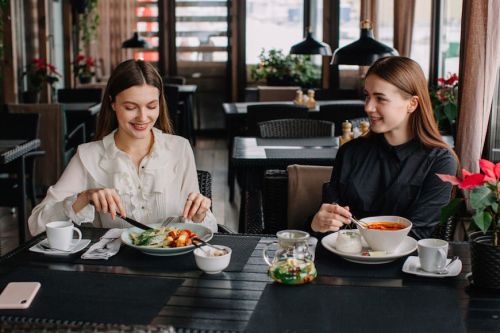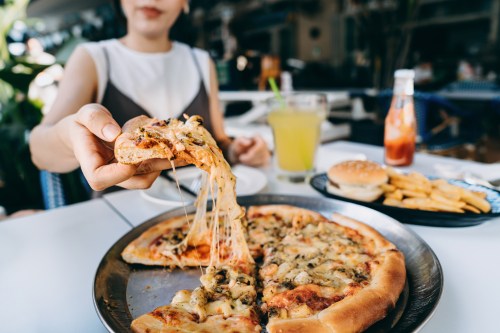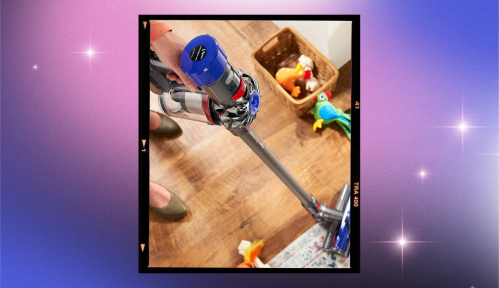Our editors independently select these products. Making a purchase through our links may earn Well+Good a commission
Let me guess what you did for lunch today:
a. Eating it at your desk while catching up on emails
b. Getting a sandwich to-go and scarfing it down on a park bench or in the car
c. Lunch? Oh, you mean the protein bar in your purse?
I wasn’t wrong, was I? Well, you’re not alone with your sad lunch habits. According to a 2018 survey of 2,000 people, 51 percent of respondents said that taking a legit lunch break during the workday is rare or unrealistic for them. Most people’s lunch “break” is less than 30 minutes—and it’s getting shorter. The truth is that once you’re out of school, lunch is an afterthought in American culture. For most workers, the idea of taking a mid-day break to actually sit down somewhere and eat with friends, whether it’s in a cafeteria or at a restaurant, is about as feasible as Twinkies becoming the next superfood.
But our collective dismissal of lunch is not doing anyone any favors. Inspired by the impending back-to-school season and all of us getting back into our healthy routines after a summer of travel, we’re here to make the case that lunch is even more important than dinner—and should be given more love and attention than it currently merits now. Your physical and mental health will thank you.
A snackable history of lunch in America
We haven’t always been a culture that skipped lunch. The Food Historian Sarah Wassberg Johnson tells me that once upon a time, the mid-day meal was a big deal. “In the 18th century, the main meal of the day was at noon,” she says. “It was actually called dinner and was a hot meal that everyone sat down and ate together,” Johnson says.
Back in the day, Americans generally had something small in the morning to eat (typically leftovers from the day before, served in the form of a hash), then went to work in the fields. This gave women time to prepare the noon meal, which required the necessary nourishment for men to finish their manual labor. Supper, the evening meal, was a smaller affair, given how exhausted everyone was by then. Even in the 19th century, when breakfast evolved to include foods like pancakes, muffins, and quick bread, Johnson says the noon meal was still the main event.
Stumped about what to eat for lunch today? Here’s the healthiest Chipotle order:
The growth of urban areas and rise in office jobs changed mid-day eating in the 20th century, Johnson says. More and more people were working city jobs, not on their own farms, and thus stopped going home for lunch. Instead, workers brought in their own food or grabbed something off a food cart—like a hot dog—and eating it on a park bench. “Maybe if you were an executive, you could take a two-hour lunch with your colleagues, but the majority of people did not have this luxury, certainly not factory workers,” Johnson says.
Women entering the workforce in larger numbers during and after World War Two, Johnson says, also helped pushed the evening meal to prominence. Lunch (as we call it now) used to be the time when the whole family would sit down together and hear about each others’ days. Now, dinner was increasingly the time where everyone was at home together.
This shift in work habits helped make lunch less of an event and more just a brief part of the work day. Times that by ten once access to email meant employees were reachable at all times and it became just a common to eat lunch holding a phone than it did a fork.
The health benefits of lunch
From a “time is money” standpoint, working through lunch may make sense, but registered dietitian Jen Scheinman, RDN, says it isn’t the best idea from a nutritional standpoint. “Biologically, having a [healthy] lunch helps regulate your blood sugar,” she says. “This is a time to get key nutrients you need to power through the day.” She says all lunches should have protein, healthy fats, fiber, and a healthy source of carbs, such as starchy vegetables—far more substantial than a protein bar and an apple. Scheinman says that clients often tell her that they experience a major energy drop around 3 p.m. and with a little prying, she often figures out that it’s usually because they’re not getting adequate nourishment mid-day.
“Something else that happens when you skip lunch—or don’t have a proper, nourishing one—is that it can cause you to overeat in the evening,” Scheinman says. Anyone else have a habit of snacking while they’re cooking dinner, or scarfing a plate full of food down in about ten minutes? Scheinman says not getting enough nutrients at lunch is likely why.
“[Lunch] is a time to get key nutrients you need to power through the day.” —Jen Scheinman, RDN
Scheinman believes so strongly in the nutritional benefits of lunch that she even goes as far as to say that it’s more important than dinner. “Breakfast, lunch, and dinner are all important, but at the end of the day, it makes sense to have something a bit smaller because you’re done exerting energy for the day, and you also don’t want your stomach to be up all night digesting food,” she says.
Besides these physical benefits, Scheinman says the mental benefits of taking a break from anything work related shouldn’t be overlooked either. “From a psychological perspective, taking a break in the middle of the day gives you a chance to regroup and relax,” she says, adding that it’s been shown to reduce stress and actually make you more productive. Given that stress and digestive problems are directly related, it’s an important connection.
What is looks like when everyone breaks for lunch
Because productivity is so prized in American culture, it’s difficult to imagine what life would be like if taking a lunch break was the norm. Of course it actually is the norm in some other cultures, like in France. Rebeca Plantier, author of the books Lessons From France and the newly out French School Lunch, explains that stopping work from 12 to 2 is engrained in French culture, even part of a daily routine for school children. “The school day in France is from 8:30 to 4:30, with a mandated hour and 40 minute break for lunch,” Plantier says. “The children sit down for a three course meal, provided by the school, for an hour, and then they play outside for 40 minutes. In France, meal time is just as much about the food as it is the social connection.”
Adults, Plantier says, take lunch breaks either at restaurants—many have special lunch menus designed to be a bit cheaper and quicker—or in the workplace cafeteria, but never at their desk. “It isn’t seen as virtuous to work during lunch. Actually, I think someone’s boss might think they were a bit weird for doing it,” Plantier says. She also emphasizes that French people aren’t on their phones while they eat either; it’s considered rude.
“It’s accepted here that taking a mid-day break is necessary to connect with people—whether it’s for business or personal—and that taking a mental break makes you a more productive worker,” Plantier adds. Similar to how French school days are longer than American schools, French workdays are longer too, with employees typically heading home around 7 p.m., or a bit earlier if you’re a working parent with kids, Plantier says. “If you have kids, dinner is usually around 7—and around 8 p.m. if you don’t—and is more of a light meal,” she says.
“It’s accepted [in France] that taking a mid-day break is necessary to connect with people—whether it’s for business or personal—and that taking a mental break makes you a more productive worker.” —Rebeca Plantier, author
In my mind, the idea of lunch in France is always at a restaurant. I ask Plantier about this, adding that it must get expensive eating out all the time. Plantier tells me some people certainly bring their lunch from home and eat it in their workplace cafeterias. She also says many workplaces also give their employees vouchers for free lunch to use at local restaurants, something that’s worked into their salaries.
Of course France isn’t the only culture that collectively takes a mid-day break. In Sweden, office workers take a mid-day coffee break, where they leave the office and talk about something other than work. In Spain, it’s not unusual to take a three-hour afternoon break, though this is changing as the workday is shifting to end earlier. And in China, a worker’s right to rest is reportedly enshrined in their constitution, and workers at certain factories and offices are encouraged to nap during their lunch break.
I wondered aloud with each of the three women I interviewed how they thought lunch would continue to evolve in America, voicing my opinion that it actually may get worse as many workplaces have moved to open floor-plan layouts, making the moments when you’re not at your desk more visible. “I really think a cultural change has to come from the top down,” Plantier adds. “If your boss doesn’t take a lunch break, you don’t feel like you can. But if he or she takes one, it makes it more permissible to take one yourself.”
Beyond individual workplace culture, Johnson says federal laws have to be taken into account when talking about lunch breaks. Currently, the Fair Labor Standard Act doesn’t require employers to provide meals or breaks. Some states are stepping in with their own provisions (New York law, for example, requires employers to provide at least 30 minutes for workers to eat during their shift) but currently, fewer than half of states require employees to let their workers take a meal break. That’s a substantial roadblock to people being able to take the time they need (and deserve) to eat a healthy lunch.
Here’s what we know: Taking a lunch break has both mental and physical benefits, yet it’s still not the cultural norm. What will it take to change it? For most of us, moving to France is out of the question. But having lunch with your boss? Maybe we start there.
See what happened when one group of colleagues started cooking for each other and taking a lunch break together.And here are five healthy lunch ideas, all under $3.
Sign Up for Our Daily Newsletter
Get all the latest in wellness, trends, food, fitness, beauty, and more delivered right to your inbox.
Got it, you've been added to our email list.











